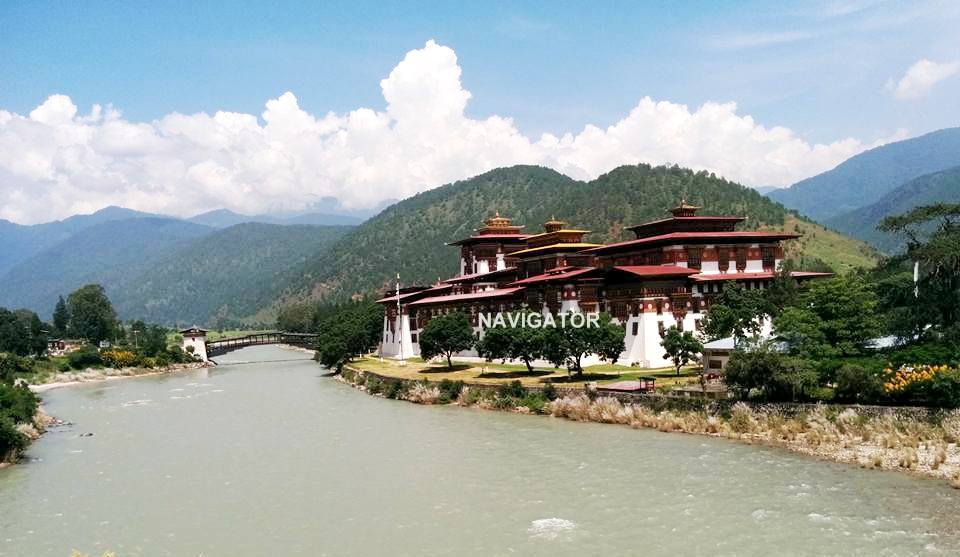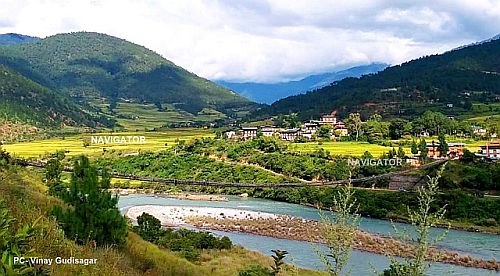Punakha
Punakha is an ancient yet long lost capital of Bhutan located between two main rivers – Mo Chhu and Pho Chhu. The city is located around 70 km from Thimphu. High hills surrounds the valley and Punakha is quite a warm destination, with annual temperature crossing over 20 degrees Celsius on average. Punakha is located around 1200m of elevation. It has wide paddy fields with two rice crops growing in a year and it looks like the meadows of paradise. Tourists can explore different things as part of sightseeing in Punakha.
Places to visit in Punakha
Punakha Dzong
The majestic fortress of Punakha Dzong is the first attraction that will keep you in awe when you arrive here at Punakha. The Palace of Great Bliss aka Punthang Dechen Phodrang Dzong seems to be like a high citadel of whitewashed stones where two rivers meet – Po (father) Chhu and Mo (mother) Chhu. The two rivers confluence by crossing the Dzong and forms the river Punakha Chhu.
The Punakha Dzong stands proudly along a row of jacaranda trees which bloom in purple color. It looks really mesmerizing with the clear blue sky. It looks really stunning and is covered in fragrant smell of incense. From Tashichho Dzong, the whole monastic body travels to the monastery in the winter season to more temperate climate. Punakha is well regarded as the winter capital of the nation. It has witnessed a lot of damages by earthquake, fire, and floods several times. But it was rebuilt well every time.
You can visit Punakha Dzong by crossing a suspension bridge of Mo Chuu River. You can reach a sharp wooden staircase to enter the dzong. The Punakha Dzong has three courtyards. In 2011, the last royal wedding was held here. In the largest event in Bhutan, Jigme Khesar Namgyel Wangchuck, the current king of Bhutan, married the new Queen, Jetsun Pema. You can also see the hall where the event was held through glass from outside.
History
In 1637, Punakha Dzong was built by The Beard Man aka Zhabdrung Ngawang Namgyel, the founder of Bhutan who also unified the nation. This dzong is where he took his last breath and his mummified body is enshrined in its holy temple. Legend has it that Guru Rinpoche (Guru Padmasambhava) predicted in the 8th century that The Beard Man (a young man) would visit the mountain which seems to be like a sleeping elephant. He would build a fort where the trunk of an elephant is placed. The mountain behind the fort clearly looks like an elephant which is sleeping and land where dzong is located looks like a trunk.
Festival
The annual festival of Punakha Tsechu is organized at Punakha Dzong. It is a dramatic event held usually in March (first month of the lunar year) which combines holy prayers and rituals with display of swordplay and horsemanship. The festival also recreates the scene of epic war between Tibetan forces and Beard Man’s army with dramatic flair. Punakha Dzong is the second largest and second oldest fort in the nation.
Dress code
If you are visiting here, dress modestly in fully covered bottom and full sleeves clothes to enter the dzong. When getting inside, your head must be uncovered. Locals have to wear their traditional dress with a scarf to enter the dzong. The timings are from 9AM to 4PM and entry fee of INR 300 or 300 Nu is charged for Indians. Read more…
Dochula Pass
Dochula is a mountain pass located on Punakha Road along Thimphu in Bhutan. It is located at around 3100m above sea level, is the highest motor-accessible point of Thimphu. Dochula Pass is beautifully facing the snow-clad mountains and houses 108 memorial chortens.
There are vivid prayer flags in Dochula Pass and it is one of the important religious and historic attractions in Bhutan. With breathtaking vistas of Mount Gangkhar Puensum, Dochula Pass is a great attraction on Thimphu valley in Bhutan.
Chimi Lhakhang
Chimi Lhakhang is a Buddhist temple or monastery in Lobesa Village in the proximity to Punakha. People consider it as ‘fertility temple’ because it blesses couples with fertility who wishes a child. It proudly stands on a small hilltop and you need to hike up the hill for 15 minutes to reach there.
The whole path passes through vivid prayer flags and orange and purple jacaranda flowers which appear in full bloom. The temple is designed well with white walls and golden roof. The temple is on a big flat ground with Bodhi tree on a side. People believe that the tree has come straight from Bodh Gaya in India.
When you enter the temple compound, the prayer wheels start whirling. In the sanctum sanctorum, you can find a huge statue of divine madman with statues of Lord Avalokiteshvara who has 1001 arms and the Beard man. Built by 14th Drukpa hierarch, Ngawang Chogyel, Chimi Lhakhang has a stupa placed by the Divine Madman (Drukpa Kinley).
Myth
The Divine Madman was well regarded to teach Buddhism in unconditional ways through comedy and songs. Legends has it that Divine Madman subdued a devil with phallus as a dog known as “Flaming thunderbolt of wisdom”. Later on, he captured demon and chartered “Chi Mi” in a chorten. This chorten has been located at the temple ground of Chimi Lhakhang. The temple also protects the wooden effigy of thunderbolt of Divine Madman which blesses the visitors.
Don’t forget to capture the serene view of Punakha River and the whole Punakha valley covered by mountains and hills at the back of the temple. The monasteries are set at a serene backdrop. There are shops selling vivid wooden phalluses at parking site of the temple. The colorful phalluses are also used to paint the exterior walls of houses here. People believe that these paints bring wealth and good luck. You can also witness the stunning and large Thangka paintings in the shop. The timings are 9AM to 5PM for the visitors. Entry is free but photography is not allowed inside the complex. You should dress well with full sleeves when visiting the temple.
Punakha Suspension Bridge
Bhutan is famous for mighty rivers and hilly terrains. There are walkable suspension bridges to cross the hilly crevices and rivers all around the nation. You can easily spot these bridges all across Bhutan. But Punakha Suspension Bridge, which is over over Po Chhu River, is Bhutan’s longest suspension bridge. It is hanging behind Punakha Dzong. This iron hanging bridge is laden with Buddhist prayer flags and is 180m long.
You can definitely indulge in the great experience of crossing the suspension bridge in Punakha. The bridge is built to serve a lot of people at a time and it keeps swaying with strong winds but it is absolutely well-built and safe. The locals often use this bridge, as it connects Punakha dzong to Punakha. It is an ideal spot for bird photography and nature photography. You can cross to the either side for capturing the serene views of the river and enjoy the soothing breeze of the river. You can visit the bridge at any time of the day.
Khamsum Yulley Namgyal Chorten
The third wife of 4th King of Bhutan built the stupa or chorten to remove evil and bring peace to the world. The chorten is on a hill which is accessible by hiking on a trail for one hour. Park your vehicle on the west side of Mo Chhu River and cross a long suspension bridge by walking to the eastern side. It is where the trek to Khamsum Yulley Namgyal Chorten starts.
The trek eventually passes from steep path along the lush green paddy fields. You can come across a big prayer wheel which chants mantras when paddy fields end. Here, elderly people can chant the mantras by sitting around the prayer wheel. The trail narrows down from here and ascends over the hill steeply through the lush green pine trees. A large Bodhi tree welcomes the visitors with two big prayer wheels at the chorten and shelter.
A well manicured garden beautifully covers the chorten. The stupa or chorten features a huge 4-storey temple and each floor having the idols of wrathful gods. The temple has nice paintings and sculptures made by the artisans here and is vivid from inside. You can have ample space to meditate, sit, and pray on each floor.
On the fourth floor, i.e. roof, you can get a mesmerizing view of nearby valley and zigzag Mo Chhu River. On the top floor sits future Buddha statue. The gorgeous views of the valley and highest level of temple are really worth your tiresome climb. The timings for the chorten are from 9AM to 5PM and entry is free.
Jigme Dorji National Park
Named after Jigme Dorji Wangchuck, Jigme Dorji National Park is the second largest national park in the country. It covers the northern parts of Thimphu, Punakha,Paro district, and Wangdue Phodrang along with the whole Gasa region. Established in the year 1974, Jigme Dorji National Park is stretched over 4316 sq. km spanning all climate zones of Bhutan from the height of 1400m to 7000m. Out of 10000 households, more than 6500 people live in the boundaries of this national park engaged in various activities, from animal husbandry to agriculture. The national park is also in the tentative UNESCO site listing.
The park serves as a sanctuary for 37 popular mammal species, including a lot of vulnerable and endangered species like snow leopard, takin, clouded leopard, Himalayan blue sheep or bharal, Bengal tiger, Himalayan black bear, black musk deer, red panda, spotted linsang, and Ussuri dhole. It also houses sambar, Indian leopard, serow, goral, barking deer, pika, marmot, and over 300 bird species. you can find the national flower “blue poppy”national bird “raven”national animal “takin” and national tree “cypress” together in this national park.
Jigme Dorji also houses economical and cultural attractions. People worship Mount Jitchu Drake and Mount Jomolhari as these are the homes to regional deity. Gasa Dzong and Lingshi Dzong are the fortresses with great historical importance. The park has the glacial lakes which are the sources of Pa Chhu, Wangdi Chhu and Mo Chhu rivers.
Jigme Dorji National Park covers most parts of northern Gaza region, along with Laya Gewogs and Lunana. These gewogs have some of the most remarkable glaciers of Bhutan.
We hope you liked the above places to visit. By considering the above places, Punakha is an important tourist destination which you must consider while planning a trip to Bhutan.

